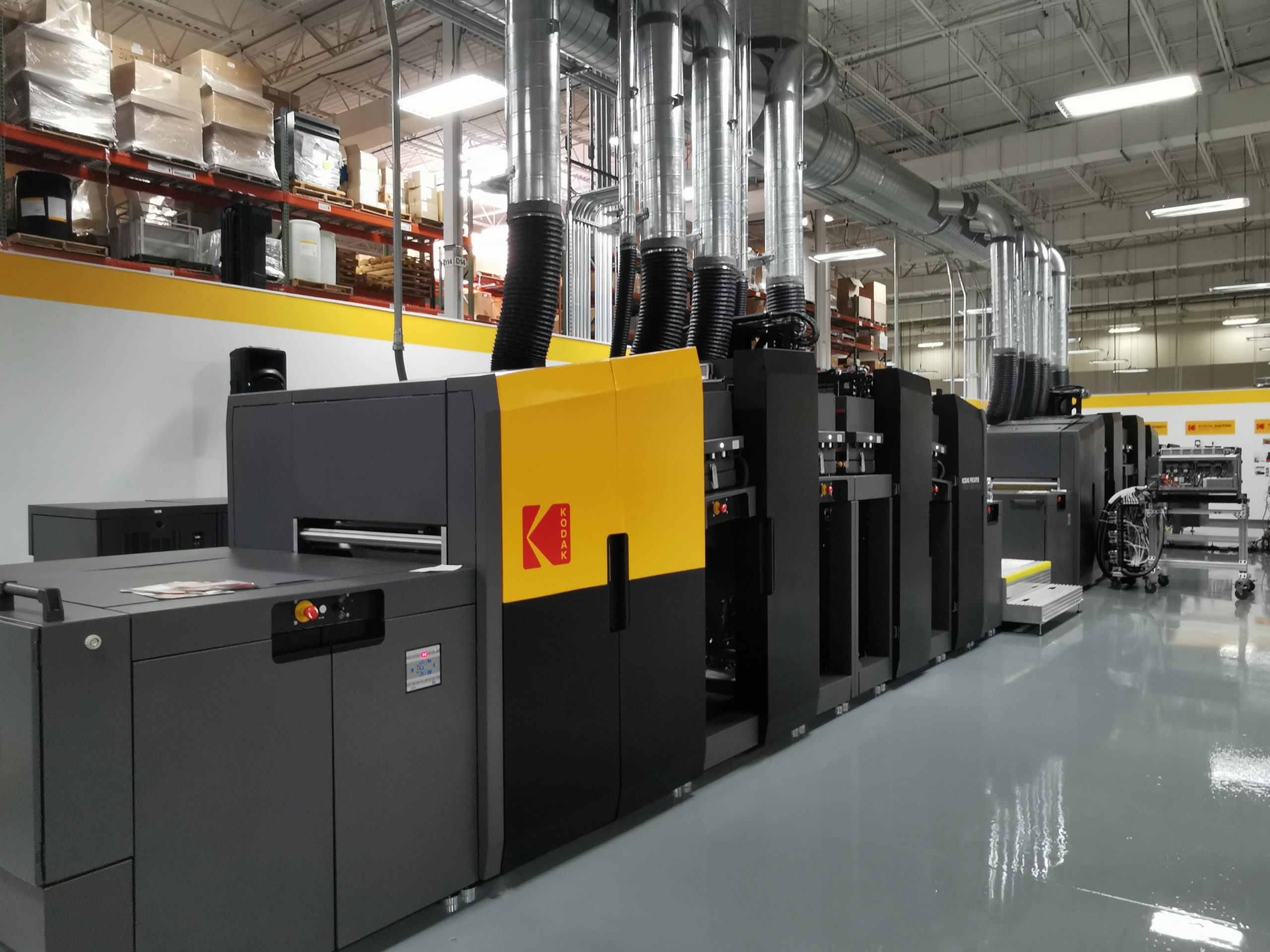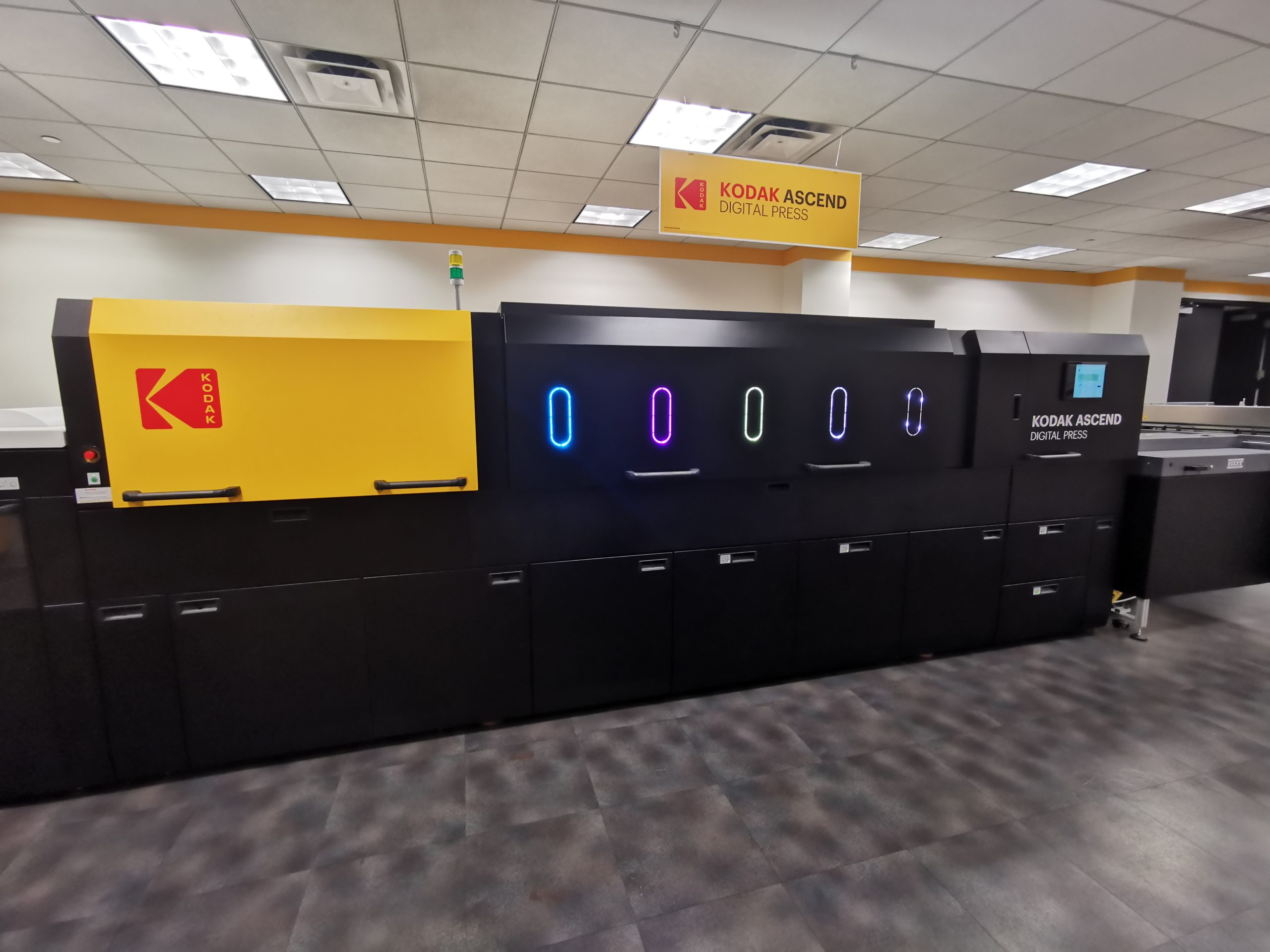It has been a while since an inkjet press manufacturer raised the bar for the print speed of inkjet presses. With the Prosper 7000 Turbo, Kodak introduced a new press that has a third higher print speed than the fastest inkjet models so far.
The Kodak Prosper heads have been able to go very fast, although only as imprinting heads in their top speed versions. Now the full speed of the Stream heads has been made available in a press as well, the Prosper 7000 Turbo. Not merely being an upgrade to the 6000, the 7000 Turbo has been re-designed to fully take advantage of the high speed. The press has three print modes, which are defined by speed and resolution.
- Quality: 650 fpm (200 m/min) at 600 x 900 dpi
- Performance: 1000 fpm (300 m/min) at 600 x 600 dpi
- Turbo: 1345 fpm (410 m/min) at 600 x 450 dpi
As resolution is not the only determining factor for image quality, Kodak prefers to talk about the achievable line screen. Approaching 200 lpi in Quality Mode, the line screen is the visual equivalent of offset print according to Kodak, while in Turbo Mode still 85 to 100 lpi can be achieved. This allows users to select the desired productivity or image quality level. The drop size is set at 9.5 pl. Print samples handed out show a good quality and colour strength even at top speed, although resolution and drop size mean that images are somewhat coarser than offset or the most recent high resolution type of inkjet printers. I would imagine the 7000 press to move into markets as mailing, transactional and newspaper printing as well as text books – where most volume is on uncoated, with the opportunity to move into coated paper on occasion.
The press supports coated and uncoated papers from 42 to 270 gsm. For coated paper the speed is limited to 200 m/min. Even board up to 24pt is possible, which is already used in Prosper 6000 folding carton print installations.

Prosper 7000 Turbo in Dayton demo centre
Prosper Press Overview
|
Prosper 7000 Turbo |
Prosper 6000 |
Prosper Ultra 520 |
|
|
Max web speed |
410 m/min |
300 m/min |
150 m/min |
|
Max A4/minute |
Up to 5,523 |
Up to 4,364 |
2,020 |
|
Imaging system |
Stream |
Stream |
UltraStream |
|
Resolution |
Up to 600 x 900 dpi |
Up to 600 x 900 |
600 x 1,800 dpi |
|
Paper range |
42 – 270 gsm |
42 – 270 gsm (C version) |
45 – 270 gsm (C version) |
|
Web width |
203 to 648 mm |
203 to 648 mm |
Up to 520 mm Up to 20.5” |
Unlike the two versions of the Prosper 6000, the 7000 is available in one version only, which is covering the full paper weight range. There is no upgrade path from the 6000 to the 7000 as the 7000 offers a noticeably higher speed and paper transport and driers have been enhanced accordingly. Again, the Kodak 800 Print Manager is used to drive the press.
The press has been presented as a reel-to-reel configuration and inline options can be added. However, offline finishing will be the norm until inline options are available that can keep up with the full speed of the press. Interstation drying using near infrared (NIR) technology is included to allow for full speed.
The Prosper 7000 is available now and deliveries are possible in the second half of 2022. A first press has been sold already. A monochrome version is not offered currently, but could be in the future depending on demand.
Expanding the product portfolio
The Prosper 7000 was not the only device presented to a wider audience for the first time last week. Originally scheduled to be shown live at drupa 2020 ,the Prosper Ultra 520 was first introduced at a virtual press conference in 2020 and is now installed at the Dayton demo centre. A detailed coverage of the press can be found here.
Realising that the Prosper 7000 is targeted at print volumes at the top end of the web-fed inkjet market, the Ultra 520 is aimed at the “mid-volume segment.” While previous Prosper presses also aimed at top end productivity, the 2,020 ppm output of the 520 is more in tune with volumes many printers have today – while pursuing a higher image quality level meeting graphic arts segment requirements – even at top speed. Accordingly, the Prosper 7000 uses the very high speed Kodak STREAM heads, while the 520 is using the ULTRASTREAM heads, which offer smaller droplets (3.75 pl) and a higher resolution. Samples showed good detail and great colour strength and do, in fact, rival offset quality. A beta site for the 520 is planned for early Q3 2022, with commercial installations before the end of the year.
Interestingly, both presses use the same ink, which should help to scale ink production and control costs. Kodak maintains that the Prosper 7000 will have the lowest running cost in the market, based on a low TCO, but also on the simplicity of continuous inkjet inks and the chemical expertise of Kodak.
Apart from inkjet, Kodak remains active in toner printing. The Ascend Digital Press, launched last year, was printing live for prospects and press visitors at the Dayton demo centre. The Ascend is based on the Nexfinity toner platform, as adapted to folding carton and signage/banner printing. For example, the press features a feeder for 1.2 m sheets that is suitable for heavy substrates at the same time. The Ascend uses high durability and high gamut toners adapted to packaging markets. A very interesting new toner allows off-line foiling in one go – instead of having to print the foil image, then apply the foil offline and print the full colour image in a second pass. Having a single print pass is achieved by printing the new foiling toner on top of the standard image, which softens at a lower temperature than the other toners in the foiling device to pick up the foil. The Ascend is available from the 29th of June.

Revitalising Kodak
There was more than the Prosper 7000 Turbo launch to the 2022 Kodak press event. CEO Jim Contineza admits that “we had lost our way.” After a thorough reorganisation when starting his tenure three years ago, the company is now reaping the benefits. In 2021 all business units of Kodak grew, and the company posted earnings of $24 million.
The company is now focussing strictly on core competencies as an advanced material and chemical company. At the same time a much stronger focus was put on serving customers and on cooperation between the business units.
Print remains a core market for Kodak technology. While offset plates, CtP and toner systems are stable businesses, inkjet is positioned to be the growth motor. With about 80 Prosper lines installed globally, the installed base is sizeable. In addition, there are a great number of imprinting heads installed. Besides the Prosper presses, Kodak has a technology partnership with Uteco for the Sapphire Evo flexible packaging press which uses the ULTRASTREAM technology driving the ULTRA 520. Currently there are 4 Sapphire Evo presses installed and in operation.
Kodak is looking into more devices and applications for its STREAM and ULTRASTREAM technologies. Packaging and décor print are likely areas for further developments and LTRASTREAM head arrays can go up to 96” width. This does surpass the 49” (1.26 m) of the Sapphire Evo Wide and allows moving into decor print where 60” in the US and 90” in Europe would be preferred widths. However narrow arrays for applications such as label print are under consideration as well. With its expertise in chemicals and surface treatment Kodak feels confident to develop the right solutions and add value for the packaging and décor markets.
Print is not the only focus area, however. For example, Kodak is leveraging its know-how in the manufacturing of advanced battery cells. Kodak applies its expertise in coating and layering as a technology partner to various battery cell producers, from pilot installations to full production. Technologies on the edge of coming to market include printed antenna based on very thin liquid copper layers and a light blocking, but IR transparent coating.
According to Jim Continenza, Kodak started to invest massively into R&D again and did not let the spending slip during the pandemic. Although Kodak maintains that the company will be “the last in film” and “the last in plates”, this paves the way for innovations and products that open up growth markets. As a long-time industry analyst, it is good to see that Kodak has regained its competitive spirit and keeps on innovating based on a long heritage in coating and advanced materials. The new presses are certainly worth a closer look and it will be interesting to see how Kodak can leverage its chemistry and coating expertise even further for new print applications.

